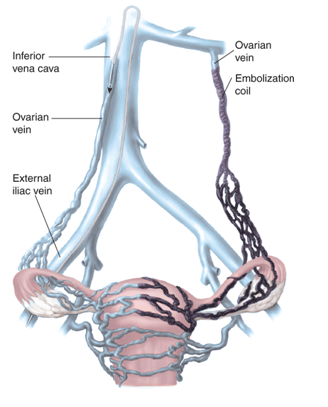Pelvic congestion syndrome (PCS) involves chronic pelvic pain unrelated to menstruation or pregnancy. It involves problems with blood flow in your pelvic veins. Blood flows backwards, causing your veins to swell and twist.
PCS affects up to 30% of women with chronic pelvic pain for which there is no other identifiable cause. Some women will have enlarged pelvic veins, but they will not be diagnosed with PCS unless there is chronic pelvic pain for at least six months.
What is pelvic congestion syndrome?
Pelvic congestion syndrome (PCS) is an abnormal enlargement of veins (varicose veins) in the pelvis, including around the ovaries. Normally, veins bring deoxygenated blood back to the heart, but when the blood cannot flow properly, blood builds up and causes veins to dilate. Disruption in blood flow can result from problems with or missing valves in the veins or compression from a tumor or other blood vessels. PCS can also occur because of pregnancy. PCS does not occur during menopause because women in menopause have less estrogen, and estrogen dilates veins. The enlarged veins in PCS are similar to other varicose veins that occur in the legs.

Symptoms and Diagnosis
The pelvic pain you experience with PCS may feel dull, achy, or heavy. Less commonly, the pain may feel sharp and intense. You may experience pain on the left side only (most common), the right side of your body, or both sides. Often, pain starts during or soon after pregnancy. It may worsen with future pregnancies.
The pain associated with PCS may feel worse:
- At the end of the day
- Before and during your period
- During intercourse and afterward
- When you stand or sit for long periods (but it feels better when you lie down)
Other symptoms include:
- Varicose veins in your pelvis, butt, thighs, vulva and vagina
- Frequent bouts of diarrhea and constipation
- Peeing accidentally from laughing, coughing, or other movements that stress your bladder
- Pain when you pee
Diagnosing pelvic congestion syndrome can be challenging because many people without pelvic pain have stressed veins similar to those who do experience pain. Imaging studies have shown that people with chronic pelvic pain and those without it may have distorted blood vessels and backflow of blood.
Even if imaging shows that your veins are dilated, you don’t need treatment unless you’re experiencing chronic pain.
Pelvic congestion as a cause of pelvic pain is a diagnosis that’s generally given after all other causes of pelvic pain have been excluded.
Treatment Options
Treatment for pelvic congestion by embolization is minimally-invasive and very effective when performed by an experienced interventional radiologist. Our patients go home on the day of their procedure and are back to normal activities within days.
Using X-ray imaging guidance, our interventional radiologists block blood flow to the veins by closing them off with a tiny metallic coils or other blocking (“embolic”) agents. Once the flow of blood through the veins is stopped, the vein shrinks and most women experience a significant reduction of their pain.
75% of people who receive vein embolization experience pain relief. Recurrence happens in only 5% of these cases.
